Thai king coronation: Sacred water, royal regalia and a housewarming party
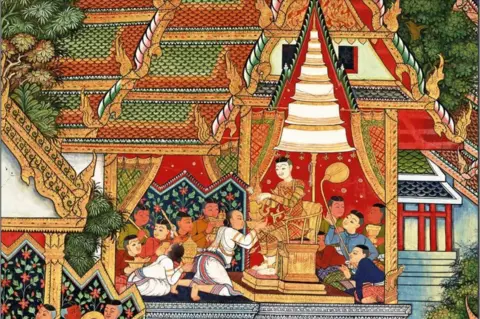 Ministry of Culture
Ministry of CultureAn elaborate three-day coronation is taking place for the king of Thailand, and sacred water plays a key role in the consecration rites.
The official ceremonies, a mix of Brahmin and Buddhist rituals, begin on 4 May in the capital, Bangkok.
King Maha Vajiralongkorn, 66, inherited the throne upon the death of his revered father King Bhumibol Adulyadej in 2016. But in Thai royal tradition only after a king is consecrated does he become a Devaraja, or God king, and the upholder of Buddhism.
This is the first coronation in living memory for most of the Thai population and big crowds are expected to attend.
"This is a significant occasion where Thai people can reassure ourselves that we have long history, rich culture and close ties between the monarchy and the people," says Prof Tongthong Chandransu from Chulalongkorn University - a researcher in Thai culture.
 European Photopress Agency
European Photopress Agency
Consecrated water
Historically, Thai society was established around the banks of its rivers which provided staples like rice and fish. So many of its ceremonies and traditions revolve around water.
For weeks leading up to the coronation, officials collected water from more than 100 sources across the country between 11:52 and 12:38 - deemed an auspicious time in Thai astrology.
The water was then blessed in Buddhist ceremonies at major temples before being combined in another consecration rite at Wat Suthat - one of Bangkok's oldest temples.
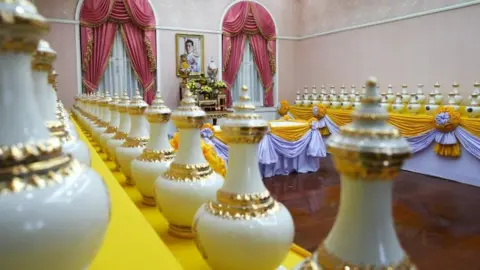 Reuters
ReutersThe consecrated water is used in two rituals at the Grand Palace. The first is the bath to "purify" the king, where the water is poured over his body while he wears a white robe.
The second is to anoint the monarch. The king changes into his full regal vestments and is seated on an octagonal throne made of fig wood.
Eight people pour the water on his hands - this time that will include Princess Maha Chakri Sirindhorn - the king's younger sister - Prime Minister Prayuth Chan-ocha, as well as Brahmins and royal court pandits (scholars).
The use of water is based on a Brahmin tradition dating back centuries, experts say.
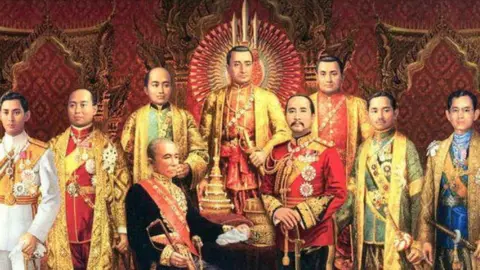 Facebook/ThailandPRD
Facebook/ThailandPRD
Gold and diamonds
The king then goes to the Bhadrapitha Throne and sits under the nine-tiered umbrella, where he is presented with the Royal Regalia.
 BBC
BBC
The crown is a more recent addition to royal tradition in Thailand, a concept popularised by European courts.
Created in the reign of King Rama I in the 1782, it is made of gold and adorned with diamonds.
It weighs 7.3kg, symbolising the weight of the responsibilities the king carries, according the Prof Tongthong.
The Royal Sword of Victory represents wisdom in governing the country. According to legend, it was found at the bottom of the Tonle Sap lake in Siem Reap, Cambodia and given as a gift to King Rama I. It's said that when it arrived in Bangkok, seven lightning strikes hit the city simultaneously.
After the crowning and investiture ceremonies King Vajiralongkorn - who holds the titles Rama X, or the 10th king of the Chakri dynasty - will present his first royal command.
His father had said at the time of his coronation in 1950: "I will reign with righteousness, for the benefit and happiness of the Thai people".
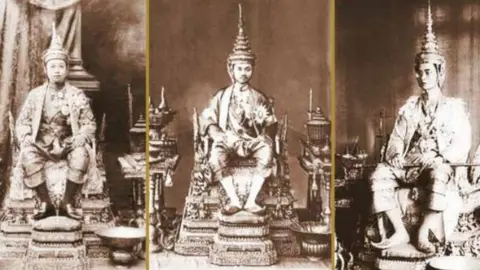 ThailandPRD
ThailandPRD
Green gourd and sesame seeds
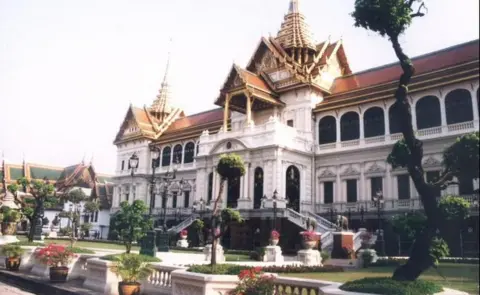 BBC
BBCAfter the coronation rites, the king takes up ceremonial residence at the Grand Palace - referred to in simple terms as a housewarming party.
In a private ceremony, at the Chakrapat Biman Royal Residence, he is escorted in by the women of the royal family.
They bring with them a cat and a white rooster, a grinding stone, a tray of green gourd, a tray of rice seeds, a tray of beans and a tray of sesame seeds. The grains represent abundance and fertility in Thai agriculture.
The significance of the cat is less straightforward. Some believe the owner of a new house should have a cat to chase away rats. Others believe the custom comes from a belief that cats expel demons and evil spirits, according to the Bangkok Post newspaper.
He's also given a golden key to signify his ownership of the palace.
In the days after the main ceremonies, the newly anointed king will take part in processions around Bangkok and make a public appearance on his balcony to give ordinary Thais an opportunity to pay their respects.
 BBC
BBC
Images courtesy of Ministry of Culture and Thailand PR department.
